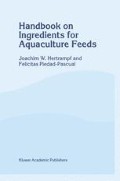Abstract
The use of the term “Unidentified Growth Factors” (UGF) dates back to around 1920, but most research work started from 1950 onwards[(16)]. They were identified in fish extract, fish meal, fermentation products and their residues and lucerne (alfalfa) meal. Particularly good sources of UGF are de-hydrated fish solubles (see chapter 21) and distillers’ feeds (see chapter 13)([4], [5], [6], [12], [14]). Squid might also be a source of UGF since there is no explanation for good performances of shrimps when added to the diet[(8)].
Access this chapter
Tax calculation will be finalised at checkout
Purchases are for personal use only
Preview
Unable to display preview. Download preview PDF.
References
Anonymous (w/o year): Amofac (UGF), a perfect blend of Unidentified Growth Factors. Helmerpharma, Enschede, (Leaflet).
Bronsch, K. (1984): Bericht über einen Ferkelaufzuchtversuch mit Octaferm Plus, Trial Report of 15.8.
Cheeke, P.R. (1987): Rabbit feeding and nutrition. Academic Press, Inc., Orlando.
DFCR (w/o year): Distillers grains. Distillers Feed Research Council, Des Moines, Iowa/USA.
Fairbanks, B.W.; Krider, J.L.; Carroll, W.E. (1944): Distillers by-products in swine rations. I. Creep feeding and growing fattening rations. J. Animal Sei., 3., 29–40.
Feltwell, R.; Fox, S. (1978): Practical poultry feeding. Faber & Faber Ltd., London.
Gropp, J.; Tiews, J.; Schulz, V. (1971: Untersuchungen über den Einfluß eines UGF-haltigen Produktes auf Wachstum und Futterverwertung von Mastküken. Z. Tierphysiologie, Tierernährung und Futtermittelkunde, 28., 102–112.
Guillaume, J.; Cruz-Ricque, E.; Cuzon, G.; Warmhoudt, A. van; Revol, A. (1989): Growth factors in Penaeid shrimp feeding. Aquacop Ifremer Actes de Colloque, 9., 327–338.
Hoppe, P.P. (1985): Vergleich zwischen Octaferm Plus und Carbadox bei Ferkeln. Trial Report 14/1985 of 18.12.
Huang, H.M.; Johanning, G.L.; O’Dell, B.L. (1986): Phenolic acid content of food plants and possible nutritional implications. J. Agric. Food Chem., 34. 48–51.
Knehans, A.W.; Kincaid, R.L.; Regan, W.D.; O’Dell, B.O. (1979): An unrecognized dietary factor for guinea pigs associated with the fibrious fractions of plant products. J. Nutrition, 109., 418–425.
Lovell, R. T. (1980): Nutritional value of solid by-products from ethanol production of corn. Auburn Techn Assistance Center, Auburn, AL/USA.
Monson, W.J. (1976): Borden reports egg output aided with unidentified factors in feed. Feedstuffs, 5.1. (reprint).
New, M.B. (1987): Feed and feeding of fish and shrimp. A manual on the preparation and presentation of compound feeds for shrimp and fish in aquaculture. UNDP/FAO/ADCA/REP/87/26, Rome/Italy.
Scholryssek, S. (1983): Einsatz von Wachstumsförderern für die Broilermast. Trial Report of 12.1.
T.D. (1988): Helmafac, the perfect blend of unidentified growth factors (UGF). Mimeograph.
Thalmann, A. (1986): Personal cummunication, 11.9.
Tiews, J. (1972): Gutachten über das Auftreten einer antibiotischen Aktivität in Octaferm. Expert opinion of 7.2.
Typpo, J.T.; Anderson, H.L.; Krause, G.F.; Yu, D.T. (1985): The lysine requirement of young growing male guinea pigs. J. Nutrition, 115., 579–587.
Rights and permissions
Copyright information
© 2000 Springer Science+Business Media Dordrecht
About this chapter
Cite this chapter
Hertrampf, J.W., Piedad-Pascual, F. (2000). Unidentified Growth Factors. In: Handbook on Ingredients for Aquaculture Feeds. Springer, Dordrecht. https://doi.org/10.1007/978-94-011-4018-8_44
Download citation
DOI: https://doi.org/10.1007/978-94-011-4018-8_44
Publisher Name: Springer, Dordrecht
Print ISBN: 978-1-4020-1527-4
Online ISBN: 978-94-011-4018-8
eBook Packages: Springer Book Archive

